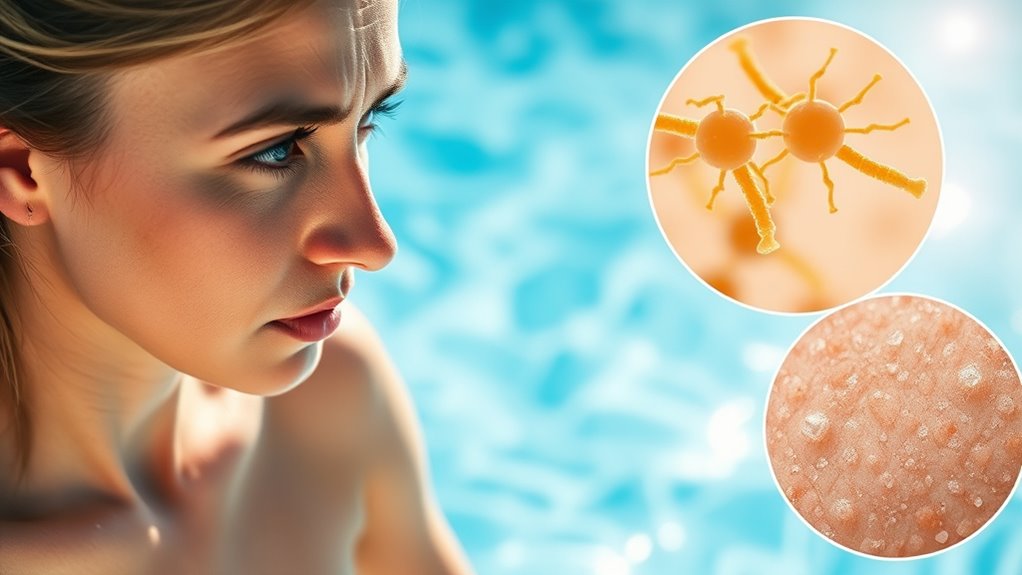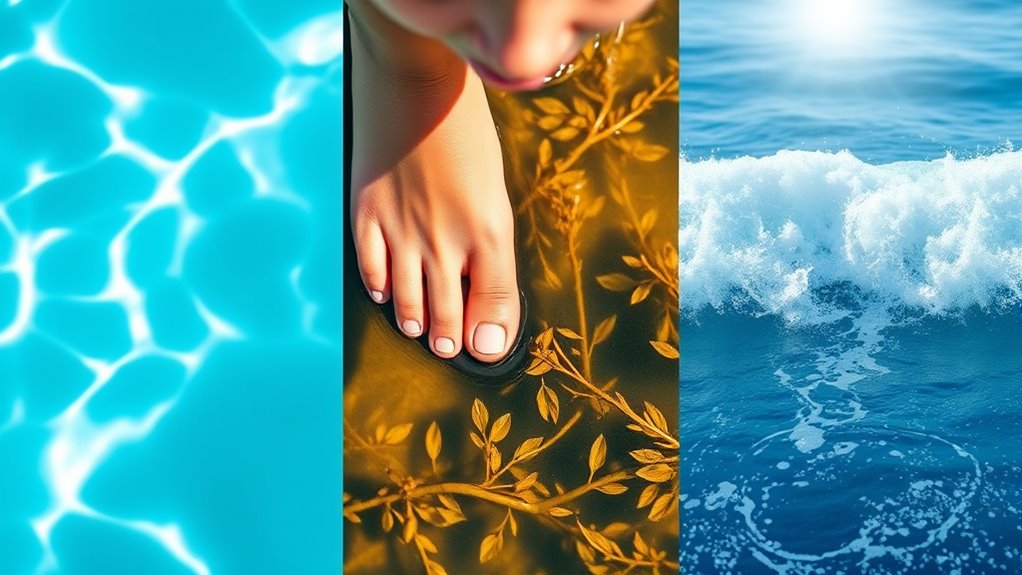Swimming can indeed worsen a yeast infection. Chlorinated pool water disrupts vaginal pH and beneficial bacteria, while prolonged moisture from wet swimwear creates ideal conditions for Candida overgrowth. You should avoid swimming during active infections, especially with severe symptoms. If you must swim, change out of wet swimwear immediately and shower with pH-balanced soap afterward. Proper pre-swim protection and post-swim hygiene can considerably reduce your risk of exacerbating existing infections.
Understanding Yeast Infections: Causes and Symptoms

Although yeast infections are common, many people don’t fully understand what causes them or how to recognize their symptoms. These infections typically occur when Candida, a naturally occurring fungus, overgrows in the vaginal area. Several factors can disrupt your vaginal flora and trigger this overgrowth, including antibiotics, hormonal changes, diabetes, and compromised immune function.
You’ll recognize a yeast infection by its hallmark symptoms: intense itching and irritation of the vaginal area, thick white discharge resembling cottage cheese, redness and swelling of the vulva, burning sensation during urination or intercourse, and vaginal soreness. These symptoms often worsen just before your period due to hormonal fluctuations. It’s crucial to distinguish yeast infections from other conditions like bacterial vaginosis or STIs, as treatments differ greatly.
How Pool Chemicals Interact With Vaginal Flora
Swimming pools contain chemicals like chlorine and bromine that maintain water safety, but these same compounds can affect your vaginal microbiome. When you’re immersed in treated pool water, these chemicals can disrupt your vaginal pH, which typically ranges from 3.8 to 4.5 in healthy conditions.
Pool chemistry involves maintaining specific chlorine levels (1-3 ppm) that effectively kill pathogens but may also eliminate beneficial bacteria that protect against yeast overgrowth. This disruption creates an environment where Candida can flourish unopposed. Moreover, the alkaline nature of most treated pools (pH 7.2-7.8) contrasts sharply with your natural vaginal acidity, potentially neutralizing your body’s natural defense mechanisms.
If you’re prone to yeast infections, understand that chemical exposure from swimming might exacerbate existing imbalances in your vaginal flora.
The Impact of Moisture and Wet Swimwear

Wearing wet swimwear creates an ideal environment for Candida overgrowth, as the trapped moisture disrupts your vaginal pH balance and natural defenses. Chlorine compounds from pool water can adhere to swimsuit fabric, potentially eliminating beneficial bacteria while allowing opportunistic fungi to flourish in the moist conditions. You’ll reduce your infection risk considerably by changing out of wet swimwear immediately, thoroughly drying the genital area, and wearing loose, breathable clothing after swimming.
Trapped Moisture Effects
When wet swimwear remains on your body for extended periods, it creates an ideal environment for yeast proliferation. The synthetic materials in most swimsuits trap moisture against your genital area, preventing proper airflow and creating a warm, humid microclimate where Candida organisms thrive.
This prolonged moisture retention disrupts your skin’s natural barrier function, making it more susceptible to overgrowth of existing yeast colonies. You’ll notice increased skin irritation as the trapped moisture causes maceration—a softening and breakdown of skin tissue that facilitates fungal penetration.
The combination of chemical irritants from pool water, friction from wet fabric, and compromised skin integrity creates perfect conditions for transforming a minor yeast imbalance into a full-blown infection. Always change out of wet swimwear immediately after swimming.
Chlorine’s Fungal Impact
Although chlorine effectively kills many harmful microorganisms in pool water, it simultaneously disrupts your body’s natural microbial balance. The vulvovaginal environment relies on beneficial bacteria to maintain an acidic pH that inhibits yeast overgrowth. Repeated chlorine exposure alters this delicate ecosystem, potentially creating favorable conditions for Candida proliferation.
When the protective lactobacilli population diminishes due to chemical irritation, your vaginal pH rises, creating an environment where fungal growth thrives. This imbalance becomes particularly problematic if you’re already managing a yeast infection. The antimicrobial properties of chlorine paradoxically contribute to dysbiosis rather than preventing it.
If you’re prone to recurring yeast infections, consider limiting extended swimming sessions during active infections, as chlorine’s fungicidal benefits against external pathogens don’t outweigh its disruption of your internal flora.
Post-Swim Care Protocol
Immediate swimwear removal after pool activities constitutes the most critical step in preventing yeast infections. Candida albicans thrives in warm, moist environments, making damp swimwear an ideal breeding ground. You’ll greatly reduce infection risk by changing into dry clothing within 10-15 minutes of exiting the water.
Proper swimwear hygiene demands thorough washing with antimicrobial detergent after each use, followed by complete air-drying before storage. Synthetic fabrics retain moisture longer than natural fibers, potentially prolonging fungal exposure.
Post-swim hydration helps flush chlorine and other chemicals from your urinary tract. Drinking 16-20 ounces of water within an hour of swimming dilutes these potential irritants. Furthermore, showering with mild, pH-balanced soap removes residual pool chemicals that might disrupt your vaginal flora and exacerbate existing infections.
Swimming in Different Water Environments: Pools vs. Lakes vs. Ocean

The environments in which you swim greatly impact your risk of developing yeast infections.
Chlorinated pools offer protection when properly maintained, as chlorine kills Candida fungi. However, inadequate pool cleanliness can create breeding grounds for microorganisms. Check pH and chlorine levels before swimming in public facilities.
Natural lake water harbors diverse lake bacteria that may disrupt vaginal flora. Freshwater lakes, especially those with limited water circulation or near agricultural runoff, present higher risks for introducing foreign microbes that could trigger yeast overgrowth.
Ocean saltwater generally poses lower risks due to its natural antimicrobial properties. The saline environment inhibits Candida growth, potentially offering therapeutic effects. However, heavily polluted coastal areas may counteract these benefits, so research water quality reports before swimming.
Protective Measures to Take Before and After Swimming
To protect yourself from yeast infections while swimming, you’ll need to employ multiple preventive strategies. Apply a waterproof barrier product before entering the water, change out of wet swimwear immediately after swimming, and rinse your body thoroughly with clean water. Choose swimwear made from moisture-wicking synthetic materials rather than cotton, as these fabrics dry faster and create less favorable conditions for yeast growth.
Waterproof Barrier Methods
Protective barriers constitute an essential defense against yeast infections when swimming in public pools or natural bodies of water. Waterproof swimwear designed with moisture-wicking properties creates a physical barrier between your genital area and potentially contaminated water. Look for suits labeled with antimicrobial technology that repel both moisture and fungal organisms.
Before swimming, consider applying antifungal barriers such as petroleum jelly to the vulvar area. This creates a waterproof seal that prevents chlorinated or bacteria-laden water from disrupting your vaginal pH balance. Silicone-based products offer superior water resistance compared to water-based lubricants.
For added protection, waterproof panty liners designed specifically for swimming can be worn under your swimsuit, though these should be changed immediately after exiting the water to prevent moisture entrapment.
Post-Swim Hygiene Protocols
While protective barriers provide defense during swimming, immediate post-swim care represents an equally significant component of yeast infection prevention. You should implement a methodical approach to minimize microbial colonization opportunities.
| Action | Purpose |
|---|---|
| Shower immediately | Removes chlorine/bacteria |
| Change into dry clothes | Eliminates moisture |
| Use pH-balanced cleanser | Maintains vaginal flora |
| Avoid douching | Preserves natural defenses |
| Pat dry thoroughly | Prevents moisture retention |
Swimming frequency should be moderated during active infections, with complete abstention recommended during severe episodes. When symptoms subside, gradually reintroduce aquatic activities while maintaining rigorous hygiene protocols. Research indicates that consistent post-swim hygiene reduces yeast infection recurrence by approximately 60%. This preventative approach addresses the principal environmental factors that typically exacerbate vulvovaginal candidiasis after water exposure.
Swimwear Material Selection
Fabric composition represents a critical determinant in yeast infection prevention for swimmers. Your swimwear choice considerably impacts vaginal health during aquatic activities. Opt for moisture-wicking materials that dry quickly and minimize prolonged dampness against sensitive tissues.
- Choose synthetic swimwear fabrics like polyester or nylon blends specifically designed for water activities
- Avoid cotton-lined swimwear, which retains moisture and creates ideal conditions for yeast proliferation
- Select swimsuits with antimicrobial properties when available
- Consider darker-colored swimwear which typically contains higher dye concentrations that may inhibit microbial growth
- Pack a second dry suit for changing immediately after swimming
Remember to thoroughly rinse chlorine-exposed swimwear and dry completely before storage. Rotating between multiple suits during frequent swimming sessions allows each garment to fully dry, reducing infection risk.
When to Postpone Your Swim: Signs Your Infection Needs Treatment First
How can you determine if your yeast infection requires medical intervention before swimming? Watch for severe symptoms like intense itching, thick cottage cheese-like discharge, and significant redness or swelling that indicate an infection requiring immediate treatment. You shouldn’t swim if you’re experiencing painful urination, fever, or if your symptoms have persisted beyond 7 days despite over-the-counter treatments.
Proper symptom recognition is essential—unusual odor or discoloration may indicate a different infection entirely, possibly bacterial vaginosis or an STI requiring specific treatment options. Consult your healthcare provider if you’re uncertain about your diagnosis or if this is your initial yeast infection. Keep in mind that chlorine can aggravate an active infection, potentially extending your recovery time. Always complete your prescribed antifungal treatment before returning to the pool.
Expert Recommendations for Swimmers Prone to Yeast Infections
For individuals who frequently experience yeast infections after swimming, implementing preventative strategies is essential to breaking this cycle. Gynecologists and dermatologists specializing in swimmer’s health recommend the following precautions:
- Change out of wet swimwear immediately after swimming to minimize moisture-trapping conditions
- Rinse your body with clean water after pool exposure to remove chlorine and other chemicals
- Use breathable, moisture-wicking undergarments following swim sessions
- Consider applying a thin layer of antifungal powder to susceptible areas before swimming
- Maintain proper vaginal pH with physician-approved products designed for swimmers
These swimming precautions greatly reduce infection risk while allowing you to continue enjoying water activities. Consistent implementation of these expert-recommended strategies can help maintain your microbiome balance even with regular pool exposure. Consult with your healthcare provider for personalized recommendations if infections persist despite preventative measures.
Frequently Asked Questions
Can Swimming Cause a Yeast Infection if I Don’t Have One?
Swimming itself doesn’t directly cause yeast infections, but certain factors can increase your risk. Poor swimming hygiene, like staying in wet swimwear for extended periods, creates a moist environment where yeast thrives. Water quality matters too—heavily chlorinated pools may disrupt your vaginal pH balance, while untreated water bodies might contain harmful microorganisms. To minimize risk, change out of wet swimwear promptly, shower after swimming, and opt for pools with proper maintenance standards.
Should I Tell My Swim Instructor About My Yeast Infection?
You don’t need to disclose your yeast infection to your swim instructor unless your symptoms are severe enough to impact your swimming performance. Swim instructors maintain confidentiality about health issues, but this information isn’t typically relevant to their instruction. If you’re experiencing significant discomfort, itching, or unusual discharge that might affect your ability to participate fully, a brief, private conversation might be appropriate. Otherwise, managing your yeast infection is a personal health matter.
Are Tampons Better Than Pads for Swimming With a Yeast Infection?
For swimming with a yeast infection, tampons offer clear benefits over pads. They absorb menstrual flow internally without becoming waterlogged. Pad drawbacks include their inability to prevent water absorption, which creates uncomfortable bulk and visible outlines through swimwear. However, be aware that tampons can potentially irritate already sensitive vaginal tissues during infection. Change your tampon immediately after swimming to minimize moisture that could exacerbate yeast overgrowth. Consult your healthcare provider for personalized advice regarding your specific condition.
Do Waterproof Antifungal Creams Exist for Swimmers?
Yes, waterproof antifungal creams do exist for swimmers. You’ll find several antifungal options specifically formulated to maintain effectiveness in water. These waterproof creams typically contain ingredients like clotrimazole or miconazole that adhere to the skin despite moisture exposure. Apply them as directed before swimming, allowing sufficient time to dry and form a protective barrier. For best results, reapply after extended water activities. Consult with a pharmacist to identify specific products designed for water resistance while treating fungal infections.
Can Men Get Yeast Infections From Swimming in Contaminated Water?
Men can’t typically contract yeast infections directly from swimming in contaminated water. Candida fungi prefer warm, moist environments but don’t effectively transmit through water exposure. Your risk centers more around poor swimming hygiene practices like remaining in wet swimwear. While waterborne infections are possible in pools, they’re usually bacterial or parasitic rather than fungal. If you’re concerned about genital irritation after swimming, change into dry clothes promptly and maintain good personal hygiene.



